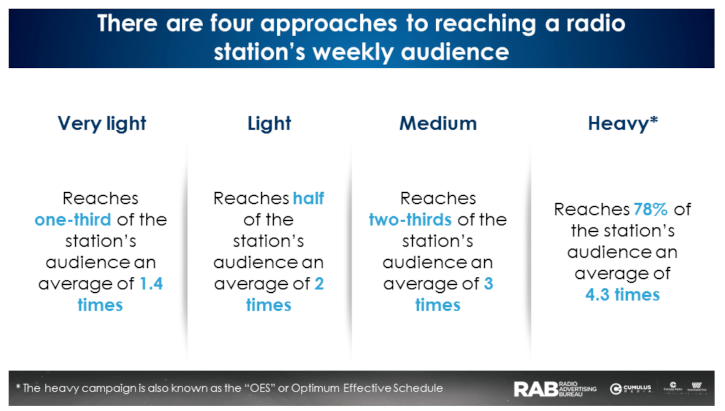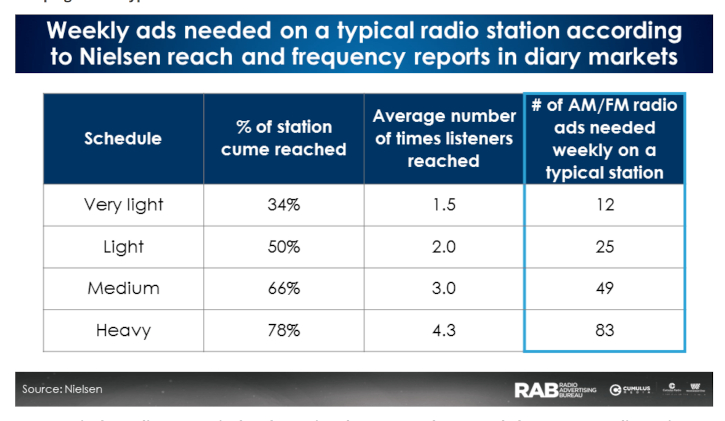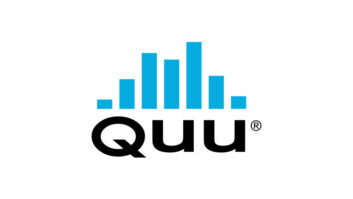Have you ever wondered how many ads you should be airing in a certain week in order to reach your audience effectively? The short answer is, “it depends on what your goals are.”
Cumulus Media/Westwood One and the Radio Advertising Bureau partnered to offer some specific guidelines for radio stations. The goal was to reach a range of listeners, ranging from a 34% reach to a 78% reach of a station’s audience, with four separate campaign goals defined as very light, light, medium and heavy.

The very light and light schedules were ideal for advertisers who want a maintenance campaign with modest levels of reach and frequency. A medium schedule is a good fit for a general sales event or promotional campaign with modest levels of reach and frequency. A heavy schedule is best for a major sales event or a product launch where many listeners are reached very frequently.
Those four approaches offer stations guidance as to how much and how often an audience is reached, wrote Pierre Bouvard, chief insights officer at Cumulus Media/Westwood One, in a blog post.
The study revealed that turnover is a key factor. Turnover is calculated by dividing a radio station’s cume (the number of different people reached by a station in a week) by its average quarter-hour audience. The greater the turnover, the more ads needed to reach an audience in a typical quarter hour. Stations with high turnovers have lower time spent listening while stations with lower turnovers have higher time spent listening.
“There’s no such thing as good or bad turnover,” Bouvard wrote. “You just need to know what it is. Turnover is a helpful ratio to understand how many commercials, promos or song spins are needed to reach a station’s audience.”
To determine the ads needed for a very light schedule, for example, take half the turn over. For a medium schedule, double the turnover.

The report also offered suggestions for different radio formats. For a top 40 station, for example, a station would need to air 15 ads, promos of song spins per week to reach 34% of its audience. To reach 78% of its audience, a station would need to air 103 ads.
The study also found that although agencies and FM/AM radio sellers agree on the number of ads needed for light schedules, they typically underestimate the number of ads needed for medium or heavy campaigns.
A companion study determined what kinds of campaigns are actually being run across the country. Cumulus Media conducted a Media Monitors analysis of AM/FM radio advertising in 99 markets during a week. The report found that during the first week of August 2020, 182,425 commercials were run on 1,685 monitoring radio stations in 99 markets. The study assigned one of the four types of schedules — very light, light, medium and heavy — in those 99 markets.
The report found that the vast majority of weekly radio station campaigns (73%) are very light, meaning they are reaching only one-third of a station’s audience. Only 2% of radio campaigns were considered heavy while 4% were considered medium intensity and 66% were considered medium.
It appears that the underestimation of the number of ads needed for medium and heavy schedules is the reason why there are so few medium/heavy campaigns, Bouvard said, even though heavy campaigns are an important strategy for advertisers.
[Read: Bouvard: More People Are “Ready to Go”]
One of the best practices as recommended by the study is that radio stations run heavy schedules of AM/FM radio ads if these advertisers are looking to generate significant impact. A previous study conducted by the National Association of Broadcasters and Coleman Insights found that advertisers who run heavy schedules rate the campaigns as excellent far more often than those running different campaigns.
The bottom line: set the right expectations with your advertisers. “Don’t expect grand opening results from a light weekly campaign,” Bouvard wrote.
Instead, press your advertisers to examine their existing plan to see if the schedule intensity matches desired results. The strategy that answers an advertiser’s concern about cost of medium- and heavy-intensity ads is two-fold: run shorter ads and run ads at all day and time periods, since ad costs for nights/weekends generally run about half of prime-time hours.
Remember, Bouvard wrote: advertising is not one-size-fits-all. “Understanding the campaign goal is crucial to determining a correct AM/FM radio plan strategy and as important as the message itself,” he wrote. “While the number of occurrences/spots needed for various campaign goals might be underestimated, the use of these tools can serve as guidelines to better optimize the AM/FM radio planning and buying process.”







